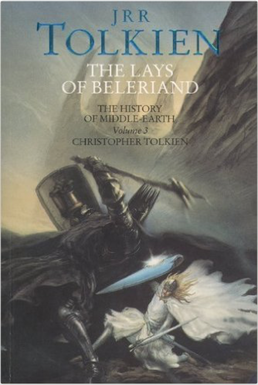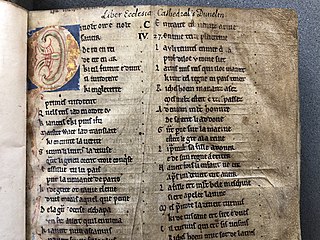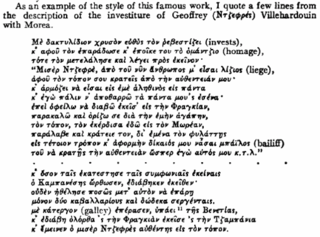Related Research Articles

Beowulf is an Old English epic poem in the tradition of Germanic heroic legend consisting of 3,182 alliterative lines. It is one of the most important and most often translated works of Old English literature. The date of composition is a matter of contention among scholars; the only certain dating is for the manuscript, which was produced between 975 and 1025. Scholars call the anonymous author the "Beowulf poet". The story is set in pagan Scandinavia in the 6th century. Beowulf, a hero of the Geats, comes to the aid of Hrothgar, the king of the Danes, whose mead hall Heorot has been under attack by the monster Grendel for twelve years. After Beowulf slays him, Grendel's mother takes revenge and is in turn defeated. Victorious, Beowulf goes home to Geatland and becomes king of the Geats. Fifty years later, Beowulf defeats a dragon, but is mortally wounded in the battle. After his death, his attendants cremate his body and erect a barrow on a headland in his memory.

Sources for an understanding of dance in Europe in the Middle Ages are limited and fragmentary, being composed of some interesting depictions in paintings and illuminations, a few musical examples of what may be dances, and scattered allusions in literary texts. The first detailed descriptions of dancing only date from 1451 in Italy, which is after the start of the Renaissance in Western Europe.
Old English literature refers to poetry and prose written in Old English in early medieval England, from the 7th century to the decades after the Norman Conquest of 1066, a period often termed Anglo-Saxon England. The 7th-century work Cædmon's Hymn is often considered as the oldest surviving poem in English, as it appears in an 8th-century copy of Bede's text, the Ecclesiastical History of the English People. Poetry written in the mid 12th century represents some of the latest post-Norman examples of Old English. Adherence to the grammatical rules of Old English is largely inconsistent in 12th-century work, and by the 13th century the grammar and syntax of Old English had almost completely deteriorated, giving way to the much larger Middle English corpus of literature.
Peter Langtoft, also known as Peter of Langtoft was an English historian and chronicler who took his name from the small village of Langtoft in the East Riding of Yorkshire.
Layamon or Laghamon – spelled Laȝamon or Laȝamonn in his time, occasionally written Lawman – was an English poet of the late 12th/early 13th century and author of the Brut, a notable work that was the first to present the legends of Arthur and the Knights of the Round Table in English poetry.

The Battle of Brunanburh was fought in 937 between Æthelstan, King of England, and an alliance of Olaf Guthfrithson, King of Dublin; Constantine II, King of Scotland; and Owain, King of Strathclyde. The battle is sometimes cited as the point of origin for English national identity: historians such as Michael Livingston argue that "the men who fought and died on that field forged a political map of the future that remains, arguably making the Battle of Brunanburh one of the most significant battles in the long history not just of England, but of the whole of the British Isles."

Thomas Hearne or Hearn was an English diarist and prolific antiquary, particularly remembered for his published editions of many medieval English chronicles and other important historical texts.

Le Roman de la Rose is a medieval poem written in Old French and presented as an allegorical dream vision. As poetry, The Romance of the Rose is a notable instance of courtly literature, purporting to provide a "mirror of love" in which the whole art of romantic love is disclosed. Its two authors conceived it as a psychological allegory; throughout the Lover's quest, the word Rose is used both as the name of the titular lady and as an abstract symbol of female sexuality. The names of the other characters function both as personal names and as metonyms illustrating the different factors that lead to and constitute a love affair. Its long-lasting influence is evident in the number of surviving manuscripts of the work, in the many translations and imitations it inspired, and in the praise and controversy it inspired.

The Lays of Beleriand, published in 1985, is the third volume of Christopher Tolkien's 12-volume book series, The History of Middle-earth, in which he analyzes the unpublished manuscripts of his father J. R. R. Tolkien.
Robert Mannyng was an English chronicler and Gilbertine monk. Mannyng provides a surprising amount of information about himself in his two known works, Handlyng Synne and Mannyng's Chronicle. In these two works, Mannyng tells of his residencies at the Gilbertine houses of Sempringham and Sixhills, and also at the Gilbertine priory at Cambridge, St Edmund’s.

Historia regum Britanniae, originally called De gestis Britonum, is a pseudohistorical account of British history, written around 1136 by Geoffrey of Monmouth. It chronicles the lives of the kings of the Britons over the course of two thousand years, beginning with the Trojans founding the British nation and continuing until the Anglo-Saxons assumed control of much of Britain around the 7th century. It is one of the central pieces of the Matter of Britain.

Guy of Warwick, or Gui de Warewic, is a legendary English hero of Romance popular in England and France from the 13th to 17th centuries. The story of Sir Guy is considered by scholars to be part of the Matter of England.
Historians in England during the Middle Ages helped to lay the groundwork for modern historical historiography, providing vital accounts of the early history of England, Wales and Normandy, its cultures, and revelations about the historians themselves.
Robert of Gloucester wrote a chronicle of British, English and Norman history sometime in the mid- or late thirteenth century.
Tail rhyme is a family of stanzaic verse forms used in poetry in French and especially English during and since the Middle Ages, and probably derived from models in medieval Latin versification.

The Brut or Roman de Brut by the poet Wace is a loose and expanded translation in almost 15,000 lines of Norman-French verse of Geoffrey of Monmouth's Latin History of the Kings of Britain. It was formerly known as the Brut d'Engleterre or Roman des Rois d'Angleterre, though Wace's own name for it was the Geste des Bretons, or Deeds of the Britons. Its genre is equivocal, being more than a chronicle but not quite a fully-fledged romance.
Handlyng Synne by Robert Manning of Brunne is a Middle English verse devotional work, intended for the use of both learned and unlearned men, dealing with the theory and practice of morality, and illustrating this doctrine with stories drawn from ordinary life. It was begun in the year 1303. It is valued today for its simple and entertaining style, and for the light it throws on English life in the Middle Ages.
Layamon's Brut, also known as The Chronicle of Britain, is a Middle English poem compiled and recast by the English priest Layamon. Layamon's Brut is 16,096 lines long and narrates a fictionalized version of the history of Britain up to the Early Middle Ages. It is the first work of history written in English since the Anglo-Saxon Chronicle. Named for Britain's mythical founder, Brutus of Troy, the poem is largely based on the Anglo-Norman French Roman de Brut by Wace, which is in turn a version of Geoffrey of Monmouth's Latin Historia Regum Britanniae. Layamon's poem, however, is longer than both and includes an enlarged section on the life and exploits of King Arthur. It is written in the alliterative verse style commonly used in Middle English poetry by rhyming chroniclers, the two halves of the alliterative lines being often linked by rhyme as well as by alliteration.

The Chronicle of the Morea is a long 14th-century history text, of which four versions are extant: in French, Greek, Italian and Aragonese. More than 9,000 lines long, the Chronicle narrates events of the Franks' establishment of feudalism in mainland Greece. West European Crusaders settled in the Peloponnese following the Fourth Crusade. The period covered in the Chronicle was 1204 to 1292. It gives significant details on the civic organization of the Principality of Achaia.

The Anglo-Saxon Chronicle is a collection of annals in Old English, chronicling the history of the Anglo-Saxons.
References
- ↑ Wood, Ian (1990-07-01). Church and Chronicle in the Middle Ages: Essays Presented to John Taylor. Bloomsbury Publishing. pp. 129–147. ISBN 978-0-8264-6938-0.
Further reading
- Summerfield, Thea (2022-05-09). The Matter of Kings' Lives: The Design of Past and Present in the early fourteenth-century verse chronicles by Pierre de Langtoft and Robert Mannyng. BRILL. ISBN 978-90-04-48503-7.